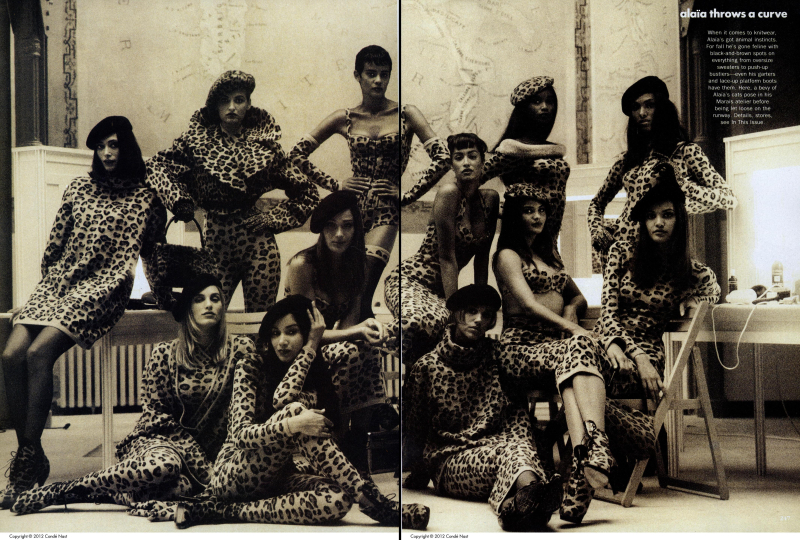The fashion world has been mourning the loss of prolific designer Azzedine Alaïa, who passed away at the age of 82 on November 18, 2017. Today’s post comes from Museum Coordinator Leigh Wishner, who shares her memories of meeting Monsieur Alaïa and watching the master at work.
**************************************************************************************************************  Vogue, Volume 181, Issue 11 (November 1, 1991), pp. 246-247
Vogue, Volume 181, Issue 11 (November 1, 1991), pp. 246-247
I know exactly when I was first smitten by Monsieur Alaïa. In my high-school days, years before I’d started down the costume and textiles career path, I was prone to ripping pages from fashion magazines that caught my eye, plastering them up on my walls for inspiration. As a child of the 80s, I had been absorbing Alaïa looks without really knowing it: zippered mini dresses, bandage gowns, etc. But in 1991, his Fall/Winter collection as featured in the pages of Vogue’s November issue captivated and stirred passions in me: a bevy of leopard-clad beauties. The grouping expressed all that I’d later come to identify with Alaïa. It was modern but shot through with 1950s bad-girl attitude; it was a mix of tough and touchable; and it displayed his unabashed, signature use of that slinky, second-skin feline pattern. Beyond this, it was a vampy hybridization of an utterly French sensibility with the femme fatale archetype I recognized from the Hollywood films I loved.
 Alaïa runway photography, 1991 F/W Collection. Michel Arnaud Fashion Photography Archive, FIDM Museum Special Collections.
Alaïa runway photography, 1991 F/W Collection. Michel Arnaud Fashion Photography Archive, FIDM Museum Special Collections.
What I didn’t anticipate as I tore out those pages is that a little more than a decade later, I’d have the opportunity to meet “the master.” My mentor, Titi Halle (director-proprietor of Cora Ginsburg LLC), took me to meet Alaïa on one of our business trips together in Paris. I am by no means shy, and my French is more than serviceable, but as we headed into his work space I mostly listened and watched. I witnessed a genuine, warm reunion between two dear friends, his gentle teasing tinged with mischief. I imagined I’d be given the newcomer’s tour and I’d see a throng of petites mains at work, a hustle and bustle of chic minions—mais non! We pulled up seats next to his station (flanked by dress forms with garments in various stages of progress), and he resumed his solitary work. With pieces of fabric, cut by his own hand. With his own needle, his own chalk, his own exactitude. I said few things, but saw the focus, the dexterity, the detail. All with the backdrop of a TV screen flashing images from a Saharan wildlife documentary.
A few years after this first introduction, while vacationing in Paris with my husband, Alaïa invited us to dine…his black Chinese pajamas subbing for chef’s whites as he skillfully assembled a meal, gathering guests around his ample kitchen table. We were among luminaries that treated us as old friends: at the end of the evening, we couldn’t believe we had been conversing and sharing laughter with a famous fashion photographer, Picasso’s granddaughter, vintage couture specialists, and Alaïa’s devoted staff. All treated equally by a generous spirit and sublime designer sans pareil.
As tributes flow in from fashion critics and editors, mega-watt celebrities, supermodels, and longstanding friends, I’m comforted to read their comments and know that my cherished encounters were, in fact, not unique, but universal. I’ve come to know that his kitchen soirées were legendary and experienced by many. I’m humbled that the rare vision I drank in with my eyes that day in his atelier has also been observed by many: that of all the contemporary fashion designers, he was the only one who crafted from start to finish, with pattern pieces cut with his own scissors, fabrics and skins pieced together by his own hands. His integrity and intuition made his designs classic; his aesthetic is distinguishable at a hundred paces. He eschewed presenting a collection based on dictates of the relentlessly churning fashion cycle. We waited until he was ready, and we were perpetually rewarded. It took confidence and conviction to thrive in the realm of fashion as he did, under the radar but revered despite it. An old proverb says that a leopard can’t change it’s spots—but if you’re wearing Alaïa’s patterned knits and printed calf, why would you want them to change?

